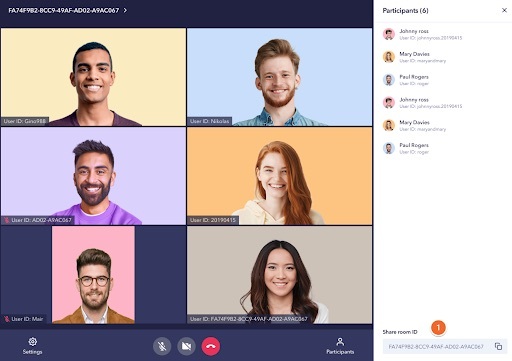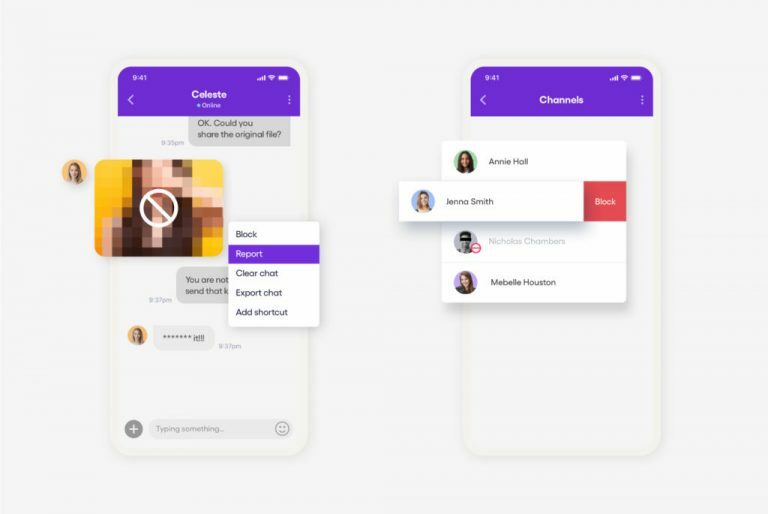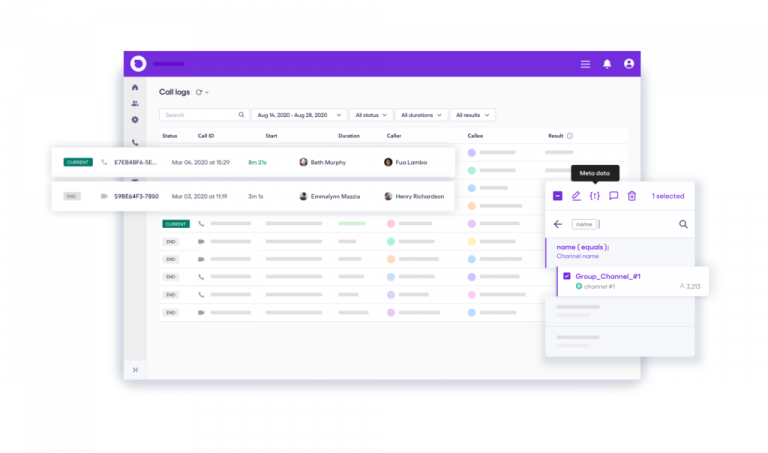The best Zoom alternative is native, in-app calling

Zoom is a video conferencing and chat app with video API services. The video conferencing platform grew from 10 million daily meeting participants in December 2019 to more than 300 million by March 2020.
For video chat, the Zoom app has been the market choice. Video chat has allowed people to connect with loved ones, and make new acquaintances, face-to-face. Video calling has been the backbone of remote work and education. It’s enabled countless business transactions ranging from job interviews to sales interactions, to customer service responses. It’s also thrown the doors to digital healthcare wide open.
In 2022, Zoom remains a popular video calling option, but as the world slowly gets used to hybrid working models, in-person classes, and live events, Zoom video API might have lost a bit of its shine for developers and the Zoom application for the rest of us.
Why Zoom in the first place?
Zoom’s video communication has a latency under 150 milliseconds (the point where lagging starts making conversations feel unnatural), because it optimizes each connection individually rather than going for the lowest hanging fruit/slowest device.
Another major draw has been its ease of use: the fact that guests can join video conferences, of up to 100 participants, by simply clicking the invite link without needing to create an account or sign in first. Users also enjoy features like being able to add custom backgrounds to hide the fact that they haven’t made their bed.
Reasons not to use Zoom
- Disconnected user experience
- Transactions off-platform
- Lacks moderation tools
- Limited analytics
- Inconsistent security standard

In-app live streaming made easy.
So why shouldn’t I use Zoom?
There are several reasons why Zoom isn’t the best choice for video calling for companies where video is an important part of the user experience. For one, the Zoom application lacks control over the UI and user experience. There’s also an absence of data ownership which prevents detailed user analytics, limited integrations, and off-and-on security and privacy concerns.
We’ll discuss these critical limitations below.
1. Lack of control over user experience
The trouble with using Zoom app – or just about any other mainstream video conferencing platform, including popular Messenger products like WhatsApp – is that you lack control over the user experience.
When you’re using someone else’s platform, you don’t own it, and you can’t customize the user interface with your branding or thoroughly integrate it into your customer journey.
If you have a buyer and seller talking on the platform about a product for sale, do you really want them going off of your platform and onto Zoom to do their communication? If you’re a coaching service or a consultation service and you’re in the business of connecting two parties together, do you want to leave control of the experience to a third party?
Moreover, if Zoom decides to change the way its core features work – as it is has been forced to do in response to security issues – you won’t be able to do anything about it and may be forced to pay more to keep using the features you’ve come to expect.
With Zoom chat as your video calling solution, you’re asking customers to jump from your app into a different product, manage a different login and account, and toggle back and forth, which is bad UX in an era when everyone expects seamless integration.
2. Doesn’t keep transactions on your platform
Keeping users on your platform for all their communication needs ensures they spend more time on your platform. And most importantly, this ensures that any transaction stays on your platform rather than going around it.
Suppose you’re a platform that makes money from transactions that occur by bringing two parties together. In that case, you really need to keep conversations on-platform to minimize fraud and make sure you’re monetizing your platform effectively.
3. The lack of moderation tools
Zoom was built to be an enterprise technology tool primarily intended to allow remote collaboration and facilitate business meetings. As such, it simply wasn’t engineered with consumer behavior – and the associated risks – in mind.
Zoom lacks features that allow for user behavior moderation, which is a big part of the reason Zoombombing – uninvited “guests” crashing Zoom calls – became an issue in the first place. For instance, the default setting for video calls was that any user could share their screen during a meeting, and the app lacked the moderation tools to prevent this.
4. Limited access to data and analytics
One of the major limitations of using someone else’s platform instead of your own is the fact that you don’t own your data and simply don’t have access to all the data and metadata generated in and around calls. Sure, enterprise Zoom offers an analytics dashboard, but it’s limited to Zoom usage.
Zoom won’t give you granular insight into what brought your users to your platform or how they use your app or platform. This kind of data can be instrumental to understanding your customers. Without access to data that tells you things like the context in which the call was initiated, there’s a limit to how well you can personalize and streamline your customer experience.
5. Multiple security flaws
As Zoom’s usage grew, a number of serious security and privacy flaws started to come to light, spurring companies like SpaceX to ban its use. To some, the phenomenon of Zoombombing might seem like another funny story about what a crazy year 2020 has been. However, when your webinar presentation or middle school class or telehealth patient consult is suddenly interrupted by a barrage of irrelevant participants, it’s not a laughing matter.
Zoom has faced criticism for falsely presenting its product as having strong end-to-end encryption. In reality, it was using sub-standard AES-128 encryption and was found to be routing calls through servers in China, making user data susceptible to seizure by Chinese authorities. The company admitted in a blog that it had been using its own definition of end-to-end encryption.
In April, it became apparent that a security flaw exposed Windows users to password theft. Soon after, it emerged that a sketchy Zoom installation shortcut for Mac created a vulnerability that could be used to access the user’s webcam and microphone. It was also found that Zoom shared user data with Facebook – even for users that don’t have Facebook accounts.
Zoom has since patched many of its security problems. Still, these issues are a testament to the fact that security testing was more of an afterthought than a priority. You might expect this from a green startup, but Zoom has been around since 2013.
Why in-app video calling is the best Zoom alternative
Sendbird Live helps you host real-time interactive video streams and calling directly in your own app so you can engage and monetize users directly.
Alternatives to Zoom like Signal, WhatsApp, and Apple’s FaceTime are gaining popularity, but for a business application, they all miss the native experience aspect.
For instance, Signal currently only supports E2EE on one-to-one video calls and requires users to share their phone number. WhatsApp, in spite of its attempts to become a business tool, is still widely viewed as a social tool. Once group chats exceed eight participants, they’re redirected to Facebook Messenger Rooms – which lack end-to-end encryption. FaceTime only works as a solution if everyone involved uses Apple devices.
We believe the best alternative is native in-app calling and video chat implemented through a trusted video calling API like Sendbird.

Let’s look at some of the advantages:
1. In-app video calling unifies user experience
With a voice and video call API, you can craft the exact user experience you need, creating a custom user interface either from scratch or assembling pre-built UI components to make short work of it.
By embedding these features into your app, you create a more unified user experience, which means users don’t have to navigate multiple apps and platforms to interact with you (or with each other). What’s more, housing your calls in the context of your app means you can access metadata, which gives you greater insight into user behavior.
2. More transactions, greater trust, less fraud
Building tools in-app like chat, voice, and video calling ensure that your customers conduct transactions within the context of your platform instead of simply using it to make initial contact with a buyer or seller and never progressing down the sales funnel.
Video calling in-app is a great way to build trust with sellers. Think of how many sales people utilize demos to sell a product. Face-to-face interaction beats everything else, and if you can get in front of your audience in a branded way, you are ahead of the game.
And as a bonus, simply having video calling API helps to build trust in your platform – especially when paired with good moderation tools that allow users to flag suspicious profiles.
In-app video chat means greater app stickiness, greater user trust, more loyal customers, and ultimately, increased revenue.
3. Moderation tools
For any company that uses live stream video to facilitate interaction with – and among – consumers, moderation tools are an essential part of providing a space where users can interact safely without being subjected to hateful or explicit content. By bringing streaming capabilities in-app, any negative experience is a direct reflection of your brand. You’ve taken the responsibility to bring users together, and now it’s your responsibility to create a safe environment for them.
If you’re planning to use your app or platform to foster connections among your customers and build a community around your brand, moderation tools are crucial.
Filters can help to automatically screen text and file message content such as URLs, file names, and in-chat profanity according to custom criteria to enforce your usage policies. Similarly, image filtering can be used to moderate images for explicit content.
It’s also important to give users the option to report and block other users that make them feel uncomfortable.

4. Data ownership & analytics
When you build video into your app with a video calling sdk, you have access to all of your video chat usage metrics and you can easily export this data for analysis. You can also set up custom metadata to automatically add information like subject lines, tags, locations, labels, or ticket numbers to your calls, making for a super user-friendly calling feature.
With custom metadata, you can offer users a highly personalized and ultra-convenient customer experience. For instance, a realtor receiving a call could see which property listings their prospective client had just looked at – right in the “incoming call” screen. With this information, it’s possible to provide more contextualized customer service in a fraction of the time it would take to ask questions and look up information.
Having full access to your app’s analytics can be a game-changer when it comes to differentiating your product from your competitors.

5. Security & privacy
With in-app calling and video conferencing, you have far greater control over your security than you do when trusting an app like Zoom.
Unless you have a massive team with plenty of experience building secure VoIP systems, we wouldn’t recommend building a video calling feature entirely from scratch. Instead, select an SDK that lets you integrate the features you need without having to worry about things like security, latency, bandwidth management, and server capacity.
Make a shortlist of video conferencing API vendors and compare their security credentials. Look out for SOC2, Privacy Shield, ISO 27001, GDPR, and HIPAA compliance. This is especially critical if you deal with sensitive data relating to finances or healthcare.
Leading vendors will offer features like end-to-end encryption and P2P routing as standard and offer additional security features such as the ability to blacklist (or whitelist) specific IPs.
Discuss your security needs with your vendor to make sure that the finer details of the scope and limitations of security features align with your expectations. Legitimate vendors will be happy to sign agreements specifying their obligations with regard to protecting your users’ data privacy.
Get all the benefits of in-app chat and video calls with Sendbird
If you’re ready to make the switch from Zoom to in-app video calling, Sendbird is just what you need.
Sendbird’s in-app chat, voice calls, and video chat allow you to build a unified user experience and make the most of your user data and metadata.
You can rest assured that your security is in good hands. Sendbird is fully HIPAA-compliant, SOC 2 accredited, and ISO 27001-compliant.
Let us deal with your video calling sdk needs while you focus on doing what you do best and what sets you apart.












